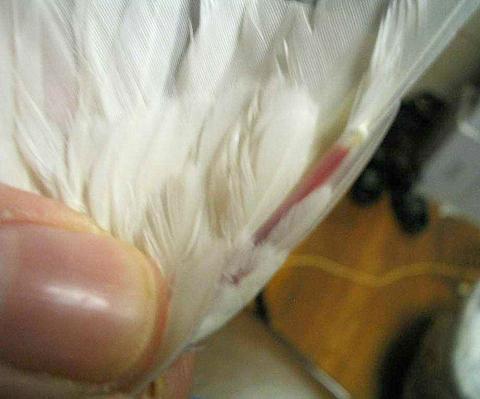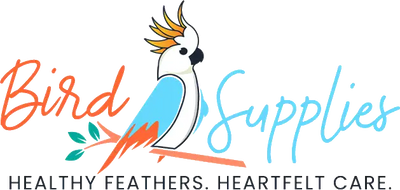Table of Contents
- Should you trim your bird’s wings? The pros & cons
- Is bird wing trimming cruel?
- Do birds feel pain when their wings are clipped?
- Which feathers do you trim when trimming wings on a bird?
- How do you cut a bird's wing feathers?
- Training for wing trims
- Needed supplies for wing trimming
- How to trim a bird’s flight feathers
In the world of avian care, few topics stir up as much debate and discussion as bird wing trimming. This practice, once considered routine, has evolved over the years, bringing with it a wave of controversy and differing opinions. In this blog post, we'll delve into the world of bird wing trimming, addressing its history, controversies, and the modern approaches that prioritize our birds' well-being and happiness. Whether you're a seasoned parrot parent or a newcomer to the world of avian companionship, this exploration will provide valuable insights to help you make informed decisions about wing trimming for your beloved birds.

Should you trim your bird’s wings? The pros & cons
These days trimming your bird's wings so that it cannot fly around the house is a controversial subject, but it has its pros and cons.
The biggest reason that most people trim bird wings is to prevent a fly-off. It just takes one time to accidentally leave the door open for a bird to fly away.
Safety is a second reason that people choose to trim their birds' wings. Every year thousands of pet birds are accidentally killed when they fly off of their play stand and into a dangerous situation, like into a ceiling fan, into water, or worse.
Some of the most common accidental bird deaths are from other household pets like cats or dogs, flying into standing water, and flying into a ceiling fan.
Now, let's weigh the pros and cons of trimming your bird's flight feathers:
PROS |
CONS |
| ✔️ If done correctly, may keep the bird safer so they can't fly into ceiling fans, windows, etc. | ✖️ Improper trimmings cause of painful, traumatic injuries when the bird gets frightened and attempts flight, but instead falls hard on the floor. |
| ✔️ Some birds are calmer with trimmed wings because they are more dependent on their owner. | ✖️ Most birds are traumatized both physically and emotionally when they can't fly |
| ✔️ May be helpful during training and socializing as the bird can't easily fly off. | ✖️ Feather plucking or vocalizing loudly may become more common in birds when they perceive limited control over their surroundings and mobility. |
| ✔️ Birds can often play on their bird stands more safely. | ✖️ Flight is an important form of exercise for birds |
| ✖️ Clipping the feathers throws the bird off balance and forces an unnatural posture which can induce arthritis later in life. |
Is bird wing trimming cruel?
Over the years, wing trimming has become increasingly controversial in the bird-owning community. One significant reason for this is the continued perception that harsh wing trims are required to modify flight. Harsh wing trims are not only outdated but can also be harmful to our feathered friends.
Avian veterinarians, who are experts in bird health, often witness the unfortunate aftermath of harsh wing trims. They see an overwhelming number of badly injured birds that have suffered accidents within their own homes due to unsupervised flight. These accidents can range from collisions with furniture to getting trapped in precarious situations. It's a heart-wrenching situation for both the birds and their caregivers.
WHILE IT IS AN INDIVIDUAL OWNER’S CHOICE WHETHER TO TRIM FLIGHT FEATHERS, WE AT THE VETERINARY CENTER FOR BIRDS AND EXOTICS PROMOTE WING TRIMS DUE TO THE NUMBER OF ACCIDENTS WE SEE IN CAPTIVE FLIGHTED BIRDS. FIRST AND FOREMOST IS SAFETY.
Do birds feel pain when their wings are clipped?
Trimming a bird's wings is not painful if you know what you're doing.
When your bird is growing a new feather, the feather is said to be "alive."
What this means is that new feathers have a large blood vein down the center of them. This vein carries blood to nourish the new feather. This is called a blood feather.

You can tell a blood feather by the pink-colored vein that is visible through the center shaft of the new feather. Once the new feather is fully developed the vein dies off and the actual feather is "dead" like your hair.
If you trim into a growing blood feather it is very painful. You could liken it to trimming into your fingernail too short. The difference is that blood literally pours out of the blood feather making for a potentially deadly situation if you can't get the bleeding to stop.

Is always critical to examine each feather that you plan to trim prior to cutting into it.
Which feathers do you trim when trimming wings on a bird?
If you choose to trim your bird's wing feathers it is important to know which feathers to clip. The photo at the top of this blog post is an image of a bad wing trim. Way too many feathers were trimmed.
Trimming too many feathers makes your bird unbalanced so that it is likely to fall off the perch at night. But, worse if your bird gets startled and attempts to fly, it will hit the ground with a harsh, painful thud that can break bones and cause internal organ damage.
Keep in mind that you only need to trim 3 - 5 wing feathers to prevent your bird from gaining lift when it attempts to fly. Leaving most of the feathers intact allows your bird to glide safely to the ground and avoid injury should it get startled and attempt to fly away.

How do you cut a bird's wing feathers?
Trimming back 3 - 5 wing feathers Is much easier than filing your bird's toenails.
Training for Wing Trims
Use Clicker Training to teach your bird to allow having their wings to be trimmed without restraint. It is much easier to carefully examine where to trim each feather when you are not worried about your bird getting loose.
Training for grooming and vet visits will reduce stress during important procedures that your bird needs such as restraint for a veterinary exam, nail trims, beak trims and wing trims.
Needed Supplies for Wing Trims:
- Round-tipped scissors with sharp cutting blades
- Bird First Aid Kit with Styptic Powder
- Clean Towel
How to trim a bird’s flight feathers
Please refer to this blog post regarding how to safely towel a bird without damaging it’s air sacs.
-
Using a clean towel, drape the towel over the bird's back and with one hand gently grasp the back of the head while restraining the legs and supporting the body with the other hand. Make sure to hold your bird gently enough around it's rib cage so as to not impair breathing.
-
Using round tip scissors carefully extend the wing by grasping the front of the wing at the joint. Cut the first 3-5 the primary flight feathers a safe distance from the coverts. If the feather shaft is pink, it is still growing and immature. Never trim immature feathers.
-
Repeat for the opposite wing if needed. Trimming just one wing will work for many birds and owners, while others want both wings trimmed. Be calm and gentle with your parrot as birds can get stressed easily.
-
Carefully observe your parrot for 10 - 15 minutes following all wing trims just to make sure that you’ve not accidentally cut through a blood feather. If you notice bleeding, apply styptic powder until the blood has clotted. Place your bird in a hospital cage and keep it quiet for at least 30 minutes. If the bleeding continues, apply pressure and more styptic powder. If bleeding still does not stop, take your bird to an avian veterinarian or an emergency animal clinic.
- Following wing trims, keep your parrot in a safe location until he learns that he cannot fly. Trim the wings as needed when the feathers get long enough for flight or before any evacuation.
For more bird grooming guidelines, Learn how to trim a bird's nails.
Should I Let My Bird Free Fly?
So, the question arises: How can we allow our birds to experience the joy of safe flight while keeping them out of harm's way? Well, there are several ideas and strategies to ensure that your bird can enjoy the skies without the risk of injury:
-
Supervised Flight: One of the safest ways to let your bird enjoy flying is through supervised flight sessions. This means you're always there to watch over them, ensuring they don't get into any trouble.
-
Flight Training: Enrolling in avian flight schools can provide both you and your bird with the necessary skills for safe flight. These schools teach not only the birds but also their caregivers how to maintain a controlled environment.
-
Bird-Proofing: Make your home bird-friendly by removing potential hazards. This includes covering windows to prevent collisions and eliminating any escape routes.
-
Harness Training: Bird flight harnesses are a great option for outdoor adventures. They allow your bird to enjoy fresh air and sunshine under your close supervision.
-
Flight Room: Consider setting up a safe, designated room in your home for your bird to fly freely. Ensure it's escape-proof and free of hazards.
-
Aviaries: If you have the space, an outdoor aviary can provide your bird with a spacious and safe environment for flight.
By following these ideas, you can strike a balance between allowing your bird to spread its wings and ensuring its safety. Remember, the well-being of your feathered companion is paramount, and with the right approach, you can create a happy and safe flying experience for them.
Related Posts:
References:
1. Veterinary Center for Birds and Exotics.Trimming Flight Feathers. Don't Just Wing it! https://avianexoticsvet.com/blog/trimming-flight-feathers-dont-just-wing-it/
2. Clipping is not necessary to keep birds safe around the house! References: Speer, B., 2015. Current Therapy in Avian Medicine and Surgery. Elsevier Health Sciences, p. 694. https://books.google.com/books?id=LKY_CwAAQBAJ
3. Jenkins, J.R., 2001. Feather picking and self-mutilation in psittacine birds. Veterinary clinics of North America: Exotic animal practice, 4(3), pp.651-667. https://www.sciencedirect.com/science/article/abs/pii/S1094919417300294
4. Rubinstein, J. and Lightfoot, T., 2012. Feather loss and feather destructive behavior in pet birds. Journal of exotic pet medicine, 21(3), pp.219-234. https://www.vetexotic.theclinics.com/article/S1094-9194(13)00089-3/pdf
5. Kubiak, M., 2015. Feather plucking in parrots. In Practice, 37(2), pp.87-95. https://inpractice.bmj.com/content/37/2/87
Diane Burroughs, LCSW is a licensed psychotherapist trained in ABA therapy techniques. She specializes in avian anxiety disorders and is certified in Nutrition For Mental Health. Diane has written a number of bird behavior books and she offers behavior consultations. She's developed a range of UnRuffledRx Science-backed Parrot Wellness Supplies.
Diane's products have been featured in the Journal of Avian Medicine and Surgery and at Exoticscon, a conference for exotic pet veterinarians. Her bird collars & supplements are stocked in avian vet clinics and bird stores throughout the US. With over 30 years in the field of behavior, Diane has created thousands of successful individualized behavior plans that help pets thrive.
TAGS: #WingTrimming #BirdWingTrimming
SHARING IS CARING! PLEASE SHARE ON YOUR FAVORITE SOCIAL MEDIA NOW!

